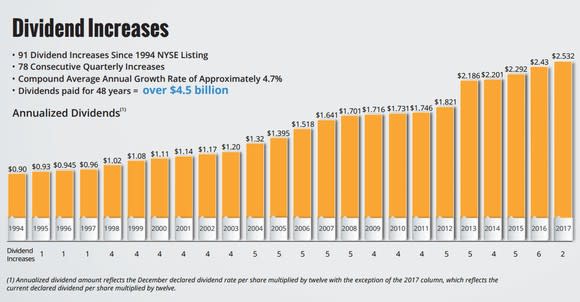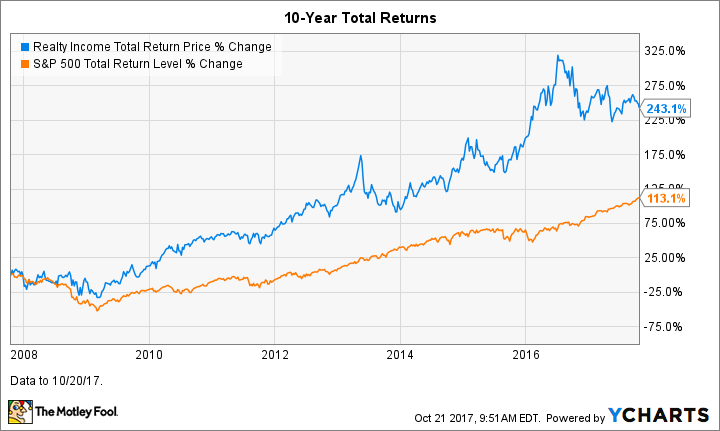Why This REIT Stock Is a Dividend Investor's Dream
If you're a dividend investor, you'd probably consider an ideal dividend stock to be one that pays a higher-than-average yield, with the dividend likely to steadily grow over time, right?
For a company to be able to consistently increase its dividend, it needs to be built on a stable foundation and have continued growth opportunities. One such company worth your investment consideration is Realty Income (NYSE: O), which is organized as a real estate investment trust.
REITs tend to have generous dividend yields -- Realty Income's yield is currently 4.6% -- because they're required to pay out at least 90% of their income as dividends in return for preferential tax treatment.

Realty Income targets specific types of tenants; these include service-based businesses, which are typically resistant to direct competition from online companies. Image source: Realty Income.
Realty Income's business
Realty Income focuses on freestanding retail occupancies in the United States and Puerto Rico. It's a well-established company that was founded in 1969, went public in 1994, and became a member of the S&P 500 index in 2015.
Realty Income owned 5,028 properties in 49 U.S. states and Puerto Rico, as of the end of the most recent quarter. The company's portfolio by rental revenue comprised 70% retailing, 13% industrial, and 7% other occupancies at that time, with a total of 250 tenants across 47 industries. The largest tenant was Walgreens, accounting for 6.7% of the company's total rental income. This geographic, industry, and individual tenant diversification helps protect the company from regional economic downturns, specific-industry economic challenges, and individual company troubles.
There are two other main factors to which we can attribute Realty Income's long-term success. First, it targets tenants that are resistant to economic slumps and direct competition from online companies. Examples include retailers that sell low-cost and/or non-discretionary products -- such as dollar stores and drug stores -- and service-based operations, such gyms. Second, the company uses long-term, triple-net leases, with annual rent increases built in. With triple-net leases, tenants pay variable costs -- property taxes, insurance, and some maintenance expenses -- greatly reducing the possibility of unforeseen expenses for the company.
Realty Income's occupancy rate was 98.3% at the end of 2016 and has never been below 96%. Its high occupancy rate coupled with its lease structure results in the company generating a very predictable and consistently rising rental income stream and cash flow from operations, enabling it to consistently increase its dividend.
Thanks largely to a successful business model, Realty Income stock's total return has crushed the market over the long term. Data by YCharts.
Why Realty Income is a dividend investor's dream
Dividend investors have much to like about Realty Income:
It has a higher-than-average yield of 4.6% and its total return has significantly outperformed the market over the long term, both largely reflecting its successful business model.
It pays its dividend on a monthly basis.
It's increased its annual dividend payout for 23 consecutive years, making it just two years away from being a Dividend Aristocrat.
It has plenty of growth opportunities, which should enable it to continue to raise its dividend.
Realty Income's yield of 4.6% is considerably higher than the average yield of 1.87% for S&P 500 stocks. Sure, there are higher-yielding stocks, but there's no such thing as a free lunch in the market -- at least not for long. Stocks that maintain very high yields for some time are almost always quite risky, have limited growth prospects, or are experiencing some other type of trouble.
Since it went public in 1994, Realty Income has raised its dividend payout every year, with its dividend growing an average of about 4.7% annually:

Image source: Realty Income.
Realty Income is the largest publicly traded retail REIT that's focused on freestanding properties, which gives it more financial muscle than its smaller peers to continue to grow by acquisitions.
A long-term play
Realty Income has a strong business model which should help drive continued success for the company over the long term, in turn helping to power continued regular dividend increases.
That said, share prices of REITs often pull back along with higher interest rates. So with expectations of continued Federal Reserve rate hikes ahead, it's particularly important for investors to use dollar-cost averaging to buy into interest-rate-sensitive stocks, such as dividend stocks.
More From The Motley Fool
Why You're Smart to Buy Shopify Inc. (US) -- Despite Citron's Report
6 Years Later, 6 Charts That Show How Far Apple, Inc. Has Come Since Steve Jobs' Passing
NVIDIA Scores 2 Drone Wins -- Including the AI for an E-Commerce Giant's Delivery Drones
Beth McKenna has no position in any of the stocks mentioned. The Motley Fool has no position in any of the stocks mentioned. The Motley Fool has a disclosure policy.


